
- Poems Poetry Art
- Author
- Alfred French (11)
- Charles Bukowski (12)
- Clarence F Underwood (6)
- Edgar Allan Poe (16)
- Edmund Spenser (7)
- Eyvind Earle (15)
- Jack Hirschman (16)
- John Hejduk (9)
- John Milton (7)
- Lance Woolaver (7)
- Lindley Murray (8)
- Patti Smith (16)
- Reilly Rhodes (11)
- Rosaleen Norton (6)
- Shel Silverstein (9)
- Unknown (9)
- Various (40)
- William Blake (9)
- William Shakespeare (7)
- Wulf Segebrecht (17)
- ... (3209)
- Binding
- Language
- Arabic (3)
- Czech & English (11)
- Dutch (5)
- Eng, Gec (3)
- English (1340)
- English, Japanese (3)
- English, Persian (3)
- English, Russian (9)
- French (43)
- Germ, German (4)
- German (45)
- German, Germ (12)
- Hebrew (3)
- Italian (11)
- Japanese (18)
- Latin (11)
- Persian (7)
- Portuguese (3)
- Russian (19)
- Spanish (13)
- ... (1881)
- Publisher
- Abrams, Inc. (12)
- Bernard Lintott (6)
- Brill (6)
- Broadside Press (10)
- De Selliers, Diane (10)
- E. Little & Co (8)
- George Olms (16)
- Gotham Press (9)
- Hard Press (15)
- Harpercollins (7)
- J.b. Metzlersche (17)
- Museum Of Modern Art (9)
- Nimbus Publishing (7)
- Rizzoli (9)
- Samuel French (7)
- Sore Dover Press (7)
- Ten Crow Press (6)
- Thames & Hudson (6)
- Unknown (11)
- X-ray Book Company (6)
- ... (3263)
- Region
- Signed
1922 Exquisite RUSSIAN ART BOOK Poetry BORIS GRIGORIEV RASEYA MIR ISKUSSTVA


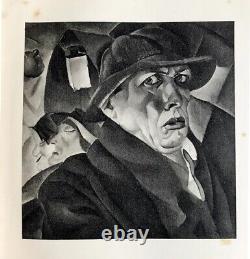
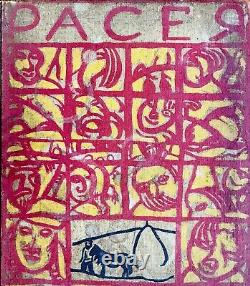
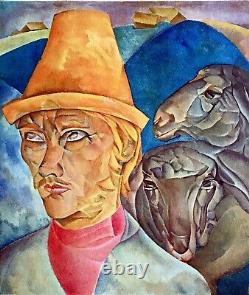
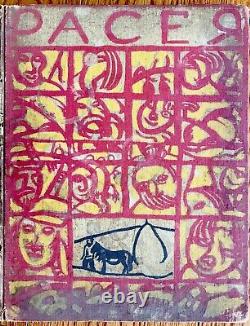
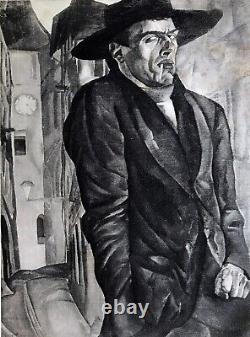
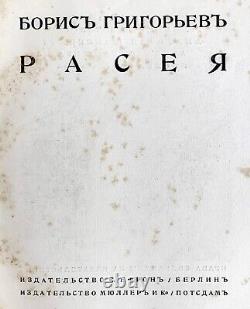
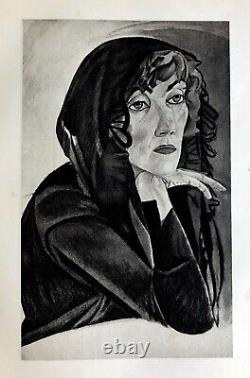
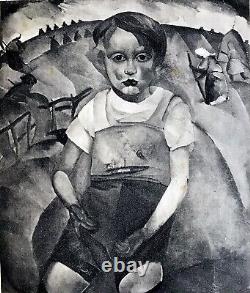
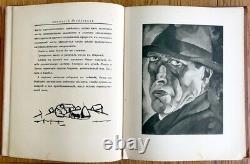
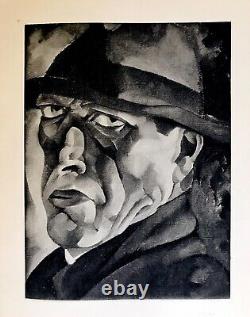
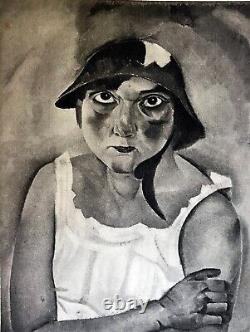
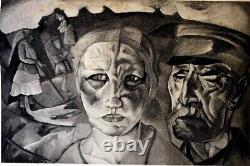
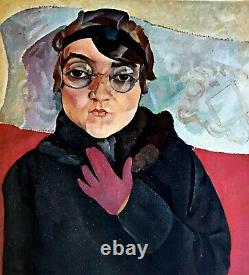
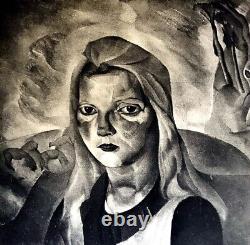
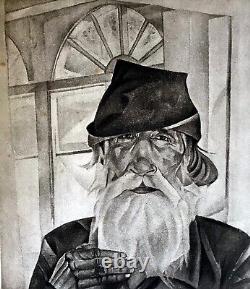
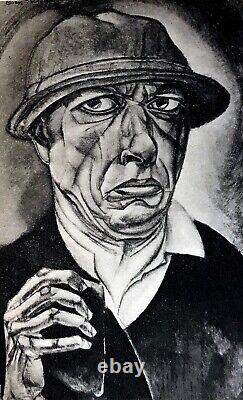
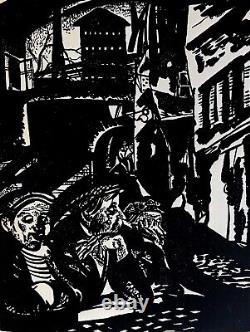
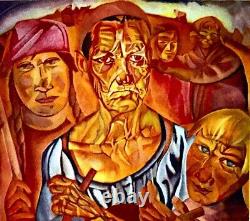
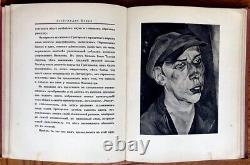
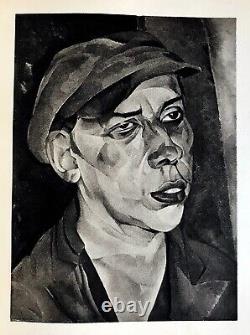
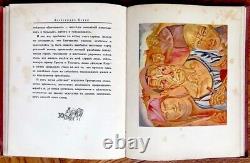
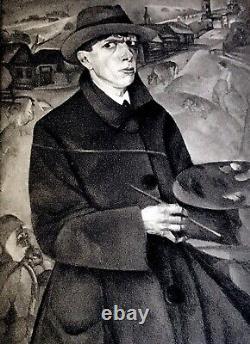


The whole ART BOOK is a piece of art. A profussion of COLORFUL and B&W paintings, Drawings and illustrations in lithographic and gravure printing quality. Most of the reproductions are FULL PAGE ones. One B&W WOODCUT seems to be an ORIGINAL WOODCUT. O riginal illustrated cloth HC. Around 170 unpaged throughout illustated pp. Cover somewhat worn and stained.
Cloth spine torn with missing material. (Pls look at scan for accurate AS IS images).
Book will be sent inside a rigid sealed protective packaging. 11 July 1886 - 7 February 1939[1] was a painter, graphic artist, and writer. Biography[edit]Grigoriev was born in Rybinsk[2][better source needed] and studied at the Stroganov Art School from 1903 to 1907 with Dmitry Shcherbinovsky. [3] Grigoriev went on to study at the Imperial Academy of Arts in Saint Petersburg under Alexander Kiselyov, Dmitry Kardovsky and Abram Arkhipov from 1907 to 1912. He began exhibiting his work in 1909 as a member of the Union of Impressionists group, [3] and became a member of the World of Art movement in 1913. [2] At that time he also wrote a novel, Young Rays. [4]After his return to Saint Petersburg in 1913[5] he became part of the Bohemian scene in St. Petersburg and was close to many artists and writers of the time, such as Sergey Sudeykin, Velimir Khlebnikov and the poet Anna Akhmatova, often painting their portraits.[citation needed]Grigoriev was also interested in the Russian countryside, its peasants and village life. From 1916 to 1918 he created a series of paintings and graphic works, Russia Raseja, Russian:????? , depicting the poverty and strength of rural Russia.
[2][3] The album started with Grigoriev's poem To her stepsons. [4] The album won a praise from influential art-critic Alexandre Benois. According to Benois, Grigoriev had shown the very essence of Russia in the period before the revolutionary upheaval. [5] The leaderless workshop he organised in September 1919 led to the creation of the Society of Young Artists. [6]However in 1919, Grigoriev travelled and lived abroad in many countries including Finland, Germany, France, [2] the United States, Central and South Americas. [5] Grigoriev lived for a time in Paris, where he attended the Académie de la Grande Chaumière. [2] In Paris he was strongly influenced by Paul Cézanne. [5] It was either at this time, or while he lived in New York - there are conflicting reports - that he had an affair with the young painter Martha Visser't Hooft, then Martha Hamlin. [7][8]In 1934 he published his poem Russia????? In the American Russian-language newspaper Novoye Russkoye Slovo. The poem was a poetic reflection of his famous Russia series of paintings. He also wrote a poem, America, which was not published until 2003. [4]Grigoriev died in Cagnes-sur-Mer in 1939.[2] GRIGORIEV Boris Dmitrievich GRIGORIEV Boris Dmitrievich1886, Moscow - 1939, Hanh, France Most of his life, BD Grigoriev was famous, dozens of his works were willingly bought by collectors and museums in Russia, France, America, Chile, the Czech Republic and other countries. He had the fame of "line artist", "great Russian artist" abroad, thanks to his colossal diligence and efficiency. I do not apologize for these phrases. You need to know for yourself who you are, otherwise you won't know what to do. Yes, and life my saint from labor beyond and feelings beyond, and my 40 years prove it.
He studied at the SHPU in Moscow (1900-07) and at the Higher Art School at the Academy of Arts in St. It was Shcherbinovsky and Kardovsky who struck the young man's imagination with their virtuoso mastery of the line and, in fact, brought up in him an attitude towards drawing and line as the basis of any work, as a genre in itself. In all other respects, the aspirations of young Grigoriev diverged from the academic school. Already in 1909, he was a member of the Impressionist Studio, headed by N. Kulbin, an association of young artists who were creatively close to the futurists.Fame in Russia came to Grigoriev after participating (starting in 1913) in the exhibitions of the association "World of Art", which exhibited his drawings, taken during short trips to Paris in 1911 and 1913. The creative and festive spirit of this city inspired him to create several thousand drawings, to daily frantic work, when time is marked only with erasable pencils, and each step brings a new plot. Concierges, clowns, garcons, townsfolk - a string of types of non-ceremonial Paris creates in these sheets a complete image of the city, seen from a certain angle.
"Intimite" ("intimacy", French) - this is how the artist called a large series of Parisian drawings. Created as if in one breath, they taught the artist's hand to unquestioningly obey his sensual sensation received from nature. The skill with which these drawings were made left no one indifferent.
Art critics in those years responded with articles to the emergence of a new talent. Punin called Grigoriev's graphics "paradoxes in space and on planes, tender, ironic and brilliant", but even then he noted the weaknesses of the artist's personality:... Before an idea, before a thought, before a real feeling, one never rises.
Grigoriev creates the cycle "Ra-sey", where the very theme of the Russian village in post-revolutionary Russia found in Grigoriev an artist who thinks, but thinks "deeply and destructively" A. All drawings and oil paintings of this cycle were made in the vicinity of Petrograd and the Olonets province.
As in the Parisian series, the images of people - peasants, children, old people - are created by virtuoso lines that give beauty and attraction to the compositions, but they, being extremely truthful in grotesque ruthlessness, they impart to forms an almost cynical deconstructiveness. The artist loved the various forms and phenomena of life, which he dissected with a beautiful graphic line, forcing nature to saturate with its power the "masterpieces" (Grigoriev's expression) of the artist. The peasants in the paintings "Village", "People's Land", "Olonets grandfather", "Old woman with a cow", "Girl with a can" stare at the viewer from the oppressive space of the compositions.In their eyes there is a dumb question, a reproach and even a threat. This is a gallery of types of the Russian village, as it was understood by most of the metropolitan artistic intelligentsia, to which the artist belonged and for whom the new cycle was a revelation. Theater - and monumental, and grotesque, and real, and conditional. He created his portrait, working with rapture, to the point of exhaustion.
In the almost square stable space of the canvas, the writer is depicted surrounded by the heroes of his works. Gorky considered this work to be his best portrait. In 1919 Grigoriev left Russia. His path lay through Finland to Germany, France, America. In 1927 he was invited to Chile as a professor at the Academy of Arts; however, due to a government coup, the invitation was canceled, but in 1936 it was again. In 1927, the artist built a house in France, not far from Nice, where in 1930, after returning from a long trip to Latin, the gallery of portraits of the Russian intelligentsia became a logical continuation of the Race cycle. The artist painted them at home and in exile. Many prominent figures of Russian culture, scientists, politicians: V.Rachmaninov (1930), actors of the Moscow Art Theater (1923) and others. Meyerhold, the theater director-innovator, whose eccentric system of creating an image was based on the grotesque, expressive gesture, silhouette, entourage, was close to the artist in this; Meyerhold turned even posing for a portrait into a creative process. The intricately broken silhouette of the director's figure, which very accurately conveys his plasticity, is the result of a search in drawings, which Grigoriev always made a great many for each portrait. In this portrait, he managed to give an ambiguous image, like America himself, worked on a large painting "Faces of the World", dedicating it to the League of Nations.
Later, this canvas was acquired by the capital of Czechoslovakia. Researchers have not yet studied what Grigoriev created during the twenty years of emigration, and it is many times greater than the number of works performed by him in his homeland. Shortly before his death, the artist completed his last self-portrait, as if putting an end to the remarkable series of portraits of the Russian intelligentsia, whose fates after October 1917 turned out so differently. Petersburg Academy of Arts under D. Experienced the influence of French cubism and painting by P. Petersburg, he entered the association "World of Art". Grigoriev created the graphic series "Rasey", in which, with obvious sarcasm and deliberate primitivism, he showed, according to Benois, the essence of Russia in the period immediately preceding the revolutionary upheaval. " After the revolution, Grigoriev, combining traditional forms with cubo-futuristic techniques and stylizations "under the primitive, together with Yu. Annenkov, tried to create a "new synthetism".Regarding the sharp, grotesque drawings of Grigoriev in his inherent paradoxical style, N. Punin wrote: His charming talent, unexpected and cheerful, but... Is devoid of temperament and any possibility of development...
All his art is in form and therefore in his talent there is no what we call spirit or genius... His soul was stolen back in the cradle 1. Benois formulated this feature of the artist more gently, as "love and extreme impressionability" 2 , which can be, like in S. Yesenin , sometimes broke through with affect, even scandalousness.
Since 1921, Grigoriev worked in Paris as a portrait painter, as well as in the USA, Central and South America. The Society of Young Artists??????
Obschestvo Molodykh Khudozhnikov was a group of Soviet artists who experimented with spatial constructions and the properties of industrial materials; active between 1919-22. ContentsFormation[edit] The "leaderless workshop", GSKhM, Moscow, 1920. From left, seated: Zharova, Kozlova, Svetlov; standing: Prusakov, ? Lentulov's workshop, GSKhM, Moscow, 1920. Standing, third from right, Komardenkov; center, Lentulov.
OBMOKhU was founded by GSKhM???? The State Free Art Workshops, itself created from the former Stroganov School students in Moscow in the autumn of 1919.
Originally, it was called OBMOLDUKh. The society has at first included the students of B. Grigoriev's workshop, who had organized in September 1919 the so called "leaderless workshop". They were joined by students of G. Yakulov's theatre-decor workshop: N. Medunetsky, Stenberg brothers; as well as A. Lentulov's painting workshop: V. [1]OBMOKhU operated at the IZO department of NARKOMPROS. In its first year the society existed mainly as the "industrial artists" artel, fulfilling the artistic needs of the new community life, the new regime. Orders came primarily from NARKOMPROS departments and commissions, and consisted mainly of posters and the decorative design for all kinds of agit and propaganda material for the new Soviet government. Many orders were received from the All-Russian Special Commission for the Elimination of Illiteracy. [2]Exhibitions[edit] Poster for OBMOKhU exhibition, 2-16 May 1920. During its period of existence, OBMOKhU organised several exhibitions. The first one took place in May 1919 with contributions by Lentulov, Medunetsky, the Stenberg brothers, Yakulov, et al. [3] The second one was held in May 1920 at the society at its base, formerly Faberge shop at Kuznetzky Bridge, with 13 students participating. [4] Another exhibition, which came to be known as Second Spring Exhibition, opened on 22 May 1921 in what has been Mikhailova Salon. [5] It appears, although not confirmed, that OBMOKhU has also taken part in the exhibition timed at the Third Congress of the Comitern, at the Continental Hotel in June 1921. Second Spring Exhibition[edit] Exhibition poster, May 1921. Invitation to the 22 May 1921 opening of Second Spring Exhibition of OBMOKhU. Second Spring Exhibition of OBMOKhU, Moscow, May-June 1921. View toward south and west walls.Constructions by Rodchenko, Medunetsky, Ioganson, and the Stenberg brothers. First reproduced in Egység 2, Vienna, 1922, p. View toward east and south walls. First reproduced in Veshch 1-2, Berlin, 1922, p. , Sovetskoe iskusstvo za 15 let, 1933, p.
138, where it is dated 1920. The event that brought fame to the society is the second exhibition (in some literature this exhibition is called the third).
Altogether, 14 artists participated: Nikolai Denisovsky, Mikhail Eremichev, Alexander Zamoshkin, Vasily Komardenkov, Sergei Kostin, Alexander Naumov, Alexander Perekatov, Nikolai Prusakov, and Sergei Svetlov, as well as the Constructivists Konstantin Medunetsky and the Stenberg brothers--who were members of Obmokhu--and Karl Ioganson and Alexander Rodchenko who were specially invited to contribute to this one show. [6]The spatial constructions of the Constructivists took up an entire hall. The Stenbergs created skeletal forms from materials such as glass, metal and wood, evoking engineering structures such as bridges and cranes, as in Georgy Stenberg's Spatial Construction/KPS 51 NXI. Rodchenko showed a series of hanging constructions based on mathematical forms; they consisted of concentric shapes cut from a single plane of plywood, rotated to create a three-dimensional geometric form that is completely permeated by space, for example Oval Hanging Construction. In 2006, the works were reconstructed from photographs and exhibited in Tretyakov Gallery [4]. In the context of contemporary artistic life of those months, this exhibition served to establish new forms, brought forth by the First Working Group of Constructivists at INKhUK which had formed by March 1921. Dispersal[edit]The society has dispersed in early 1922, some participants continued to work under different banners: as "Constructivists", in 1922, with K. Medunetzky and the Stenberg brothers; as "The First Working Artists Organization", from 1924 onwards, with G. Yakovlev; and in 1925 N. The Constructivists signed a manifesto condemning non-useful i. Fine' art as a'speculative activity', and thereafter devoted themselves to theatrical or industrial design. , World of Art was a Russian magazine and the artistic movement it inspired and embodied, which was a major influence on the Russians who helped revolutionize European art during the first decade of the 20th century. The magazine had limited circulation outside Russia. [1] From 1909, several of the miriskusniki i. Members of the movement also participated in productions of Sergei Diaghilev's Ballets Russes company based in Paris. Foundation The artistic group was founded in November 1898 by a group of students that included Alexandre Benois, Konstantin Somov, Dmitry Filosofov, Léon Bakst, and Eugene Lansere.[2] The starting moments for the new artistic group was organization of the Exhibition of Russian and Finnish Artists in the Stieglitz Museum of Applied Arts in Saint-Petersburg. [3] The magazine was co-founded in 1899 in St. Petersburg by Alexandre Benois, Léon Bakst, and Sergei Diaghilev (the Chief Editor). [3] They aimed at assailing artistic standards of the obsolescent Peredvizhniki school and promoting artistic individualism and other principles of Art Nouveau. The theoretical declarations of the art movements were stated in Diaghilev's articles "Difficult Questions", "Our Imaginary Degradation", "Permanent Struggle", "In Search of Beauty", and "The Fundamentals of Artistic Appreciation" published in the N1/2 and N3/4 of the new journal.
The sixth exhibition was seen as a Diaghilev's attempt to prevent the separation from the Moscow members of the group who organized a separate "Exhibition of 36 artists" (1901) and later "The Union of Russian Artists" group (from 1903). [5] The magazine ended in 1904.
Its place was inherited by the Union of Russian Artists which continued officially until 1910 and unofficially until 1924. The Union included painters (Valentin Serov, Konstantin Korovin, Boris Kustodiev, Zinaida Serebriakova, Sergei Lednev-Schukin), illustrators (Ivan Bilibin, Konstantin Somov, Dmitry Mitrohin), restorators (Igor Grabar), and scenic designers (Nicholas Roerich, Serge Sudeikin). [6] In 1910 Benois published a critical article in the magazine Rech' about the Union of Russian Artists. Nicholas Roerich became the new chairman.
The group admitted new members including Nathan Altman, Vladimir Tatlin, and Martiros Saryan. Some said that the inclusion of Russian avant-garde painters demonstrated that the group had become an exhibition organization rather than an art movement. In 1917 the chairman of the group became Ivan Bilibin. The same year most members of the Jack of Diamonds entered the group. The group organized numerous exhibitions: 1911, 1912, 1913, 1915, 1916, 1917, 1918, 1921, 1922 Saint-Petersburg, Moscow. The last exhibition of Mir iskusstva was organized in Paris in 1927. Some members of the group entered the Zhar-Tsvet (Moscow, organized in 1924) and Four Arts [ru] (Moscow-Leningrad, organized in 1925) artistic movements. Art Ivan Bilibin's illustration to The Tale of the Golden Cockerel. Like the English Pre-Raphaelites before them, Benois and his friends were disgusted with anti-aesthetic nature of modern industrial society and sought to consolidate all Neo-Romantic Russian artists under the banner of fighting Positivism in art. Like the Romantics before them, the miriskusniki promoted understanding and conservation of the art of previous epochs, particularly traditional folk art and the 18th-century rococo. Antoine Watteau was probably the single artist whom they admired the most. Such Revivalist projects were treated by the miriskusniki humorously, in a spirit of self-parody. They were fascinated with masks and marionettes, with carnaval and puppet theater, with dreams and fairy-tales. Everything grotesque and playful appealed to them more than the serious and emotional. Their favorite city was Venice, so much so that Diaghilev and Stravinsky selected it as the place of their burial. As for media, the miriskusniki preferred the light, airy effects of watercolor and gouache to full-scale oil paintings. Seeking to bring art into every house, they often designed interiors and books. Bakst and Benois revolutionized theatrical design with their ground-breaking decor for Cléopâtre (1909), Carnaval (1910), Petrushka (1911), and L'après-midi d'un faune (1912). Apart from three founding fathers, active members of the World of Art included Mstislav Dobuzhinsky, Eugene Lansere, and Konstantin Somov. Exhibitions organized by the World of Art attracted many illustrious painters from Russia and abroad, notably Mikhail Vrubel, Mikhail Nesterov, and Isaac Levitan. In 1902 Benois and'Mir Iskusstva' established a publishing house. They created postcards with reproductions of art masterpieces,'educational' postcards with short commentaries and pictures from different fields of science geography, zoology, etc. However, the demand was rather low. They published guide-books on Pavlovsk, St Petersburg, Hermitage Museum, an exquisite edition of The Bronze Horseman with illustrations by Benois and many more.
